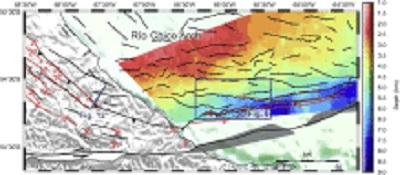J.P. Ormazabal, J.I. Isola, F.I. Palma, J.G. Lozano, F. D. Esteban, M.M. Menichetti, E. Lodolo, A.A. Tassone
2 020
Journal of South American Earth Sciences Volume 103, November 2020, 102708
In this study, we examine the external part of the Magallanes-Malvinas Fold and Thrust Belt in offshore areas, including a portion in Tierra del Fuego onshore, in southern South America. Our investigations focus on the interaction between a thin-skinned fold and thrust belt and the basement in that deformation, considering pre-existing structures acting as stress risers and localizing a possible tectonic inversion. The data is composed of around 14,000 km of 2-D multichannel seismic lines and three exploratory wells, used to analyse the anticlines of the fold and thrust belt in the area. The strike of these folds progressively evolves from NW-SE trending in western onshore regions, to WSW-ENE trending in eastern offshore areas. The fold and thrust belt shows a buttressing effect against the Río Chico Arch. The most shortening is seen in the apex of the Río Chico Arch around 67° W, in the coast of Tierra del Fuego, and gradually decreases eastwards in offshore regions. A connection between basement-involved faults and folds offshore is inferred from the analysis of the Géminis and Ciclón anticlines, developed during the N–S last compressional stage of deformation in the late Oligocene/early Miocene. The Géminis anticline is a fault propagation fold with a total shortening of 205 m with a piggyback basin developed over its backlimb. The location and ENE-WSW strike-direction of the fold have been controlled by a basement-involved fault. The Ciclón anticline is a subtle fold trending WNW-ESE developed as a result of the slight tectonic inversion of a negative flower structure.
https://www.sciencedirect.com/science/article/abs/pii/S0895981120302510?via%3Dihub

